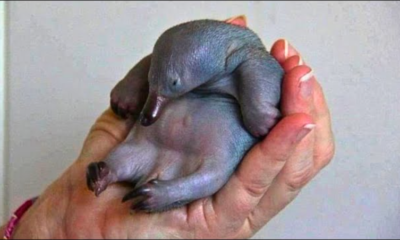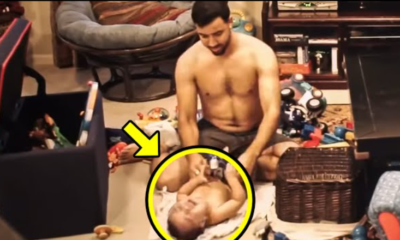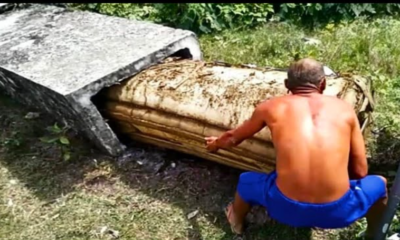Inspirational
Girl Gives Seat To Old Man, But Then The Security Camera Catches Something Incredible!

It was a typical day in Tokyo, and everyone was eager to arrive at work on time. The subway was packed with people when suddenly, a Japanese girl stood up and generously offered her seat to an old man. She couldn’t bear to see him standing the whole time. However, when she realized who the man was, something extraordinary happened.
The girl named Hena regularly used the metro to travel to school, as she needed to cover a considerable distance. Having a seat was a welcome luxury. Upon entering the subway, she quickly surveyed the crowded space. All seats were taken except for one. If she had arrived a few seconds later, she would have missed the opportunity.
Grab This Opportunity Now👇👇👇
Grab This Opportunity Now👇👇👇
Hastily, she walked to the empty seat and sat down, ready to relax before her busy life as an art student began. Unaware that her life was about to take an unexpected turn, Hina dropped her heavy bag on the floor and sighed in relief.
The metro stopped at the next station, and at the end of a long queue of people, an elderly man barely managed to get inside. He searched for a seat but found none in the packed metro. Astonishingly, no one seemed willing to help him.
Observing the situation, Hina watched in awe and decided to take action. When the elderly man approached her, she valiantly gave up her coveted seat. “Here, Mister, take a seat, please,” she offered. The man looked at her appreciatively and, with some struggle, managed to sit down.
Surprised by the act of kindness, his face lit up throughout the ride. Hina occasionally checked on the old man by glancing over her shoulder. Each time she did, he was already looking at her. The oddity of the situation made her wonder if they knew each other. Despite the man’s peculiar behavior, she smiled kindly, reassuring him that it was no problem.
As the ride continued, the old man kept staring at her, leaving Hina to ponder the mystery of their unexpected connection. At first, Hina didn’t mind and simply ignored the old man’s persistent staring, thinking he would eventually stop. However, to her surprise, he didn’t. “What is he doing?” Hina mumbled under her breath.
When the metro stopped at the station, the old man wanted to get off, but he struggled immensely to get up and leave the train. Setting aside her feelings, Hina decided to take action and help the old man once again. Once outside, the man thanked her heartily and wished her a good day.
Hina returned to the metro, reflecting on the unusual start to her day with a smile. “What a start to the day!” she mumbled. Not long after, she arrived at her own stop, got off, and suddenly realized she had left her bag on the train.
She hurriedly ran back to grab her backpack, feeling relieved when she retrieved it. However, something else caught her attention on the seat she had vacated for the old man – an envelope. Confused, she picked it up and noticed there was no writing on the outside. Assuming the old man had probably forgotten it, Hina pondered what to do.
Unable to go back, she decided to pocket the envelope. As Hina stepped out of the metro and started walking toward her school, she placed the envelope in the front pocket of her bag. She intended to track down the old man in her free time, suspecting that the envelope belonged to him. Unaware of where this would lead her, thoughts lingered on the mysterious envelope.
On her way to school, she wrestled with the idea of looking inside. Should she take a peek? She shook her head, reminding herself that it wasn’t right to invade someone’s privacy. However, the thought persisted that it might help her find the old man.
Her thoughts vacillated until she arrived at school, where everything changed. As soon as she set foot on the school grounds, a group of girls ran toward her, shouting, “Hana, you’re on TV!” Hana was bewildered. She was on TV, but before she could ask, she was kind of dragged into an empty classroom, where one of the girls showed her the footage.
Shocking Hina, the footage displayed a subway compartment that she immediately recognized. It was the one she was in just moments ago. The video showed security footage capturing an old man getting out of the metro with a girl’s help. Following this, the video cut to the old man saying something unbelievable.
“I accidentally left a very, very important envelope on the subway, and I really need to get it back,” the old man said. When Hina heard this, her hand instinctively moved to the front of her bag. Her thoughts were right; he did leave the envelope there. However, the video wasn’t over yet. It cut back to the security footage, showing H picking up the envelope.
The man returned on the screen, looking desperate, and pleaded, “Please reach out to me.” Without hesitation, Hina started to run toward the subway, remembering the station where the man was. It was just one stop from the station closest to her school, so maybe the man was still there.
As she sat down in the metro, she checked the front pocket of her bag, ensuring the envelope was still there. To her surprise, she noticed the envelope wasn’t sealed. Curious, she looked inside and exclaimed loudly as her eyes grew wide. Inside the envelope was a big, intricately designed key.
She frowned, wondering what the key would lead to. It looked valuable, so Hina could understand why it was important for the old man. Happy to see she was almost at the right station, moments later, the metro came to a halt at the station she saw in the footage.
“Okay, what now?” Hina mumbled. It was quite a big station with six platforms. Would the old man still be here, and if he was, where would he be? With determination, she started to run across a platform. Hina’s heartbeat increased from all the running, and she started panting.
But then she saw him. The old man was sitting on a bench on the other side of the station. She rushed toward him. “Excuse me,” Hina said, breathless. “You left this envelope on the train, and I wanted to return it.” The old man looked up, his eyes widening in surprise. “Thank you, young lady,” he said, his voice filled with gratitude. “I kept something special in the envelope. This key has been in my family for generations, and I was worried I’d lost it forever.”
Hina smiled at the man, happy to have been able to help. “I’m just glad I could return it,” she said. The old man smiled and told her that she reminded him of his granddaughter, always ready to help just like her. Hina smiled back and assured him it wasn’t a problem.
Then something incredible happened. Hina’s curiosity gave the upper hand, and questions blurted out. “What does the key open?” she asked, slapping her hands in front of her mouth in surprise. However, the old man just smiled. “I can show you if you like,” he said.
Hina agreed instantly, not knowing how it would turn out. She was surprised when the old man invited her to come with him
. Why would he invite someone to something so important to him? The more she thought about it, the weirder it got, and a little worry started to creep in. But surely the old man couldn’t harm her, right?
To dispel some of her worries, Hina started to ask the old man some questions. To her surprise, he was very open, and her worrisome thoughts instantly vanished as he explained that the key belonged to a bank vault containing his family heirloom. He would love to show it to her.
Hina hesitated for a moment but then agreed to come. They boarded the subway train and rode silently, the old man clutching a small bag close to his chest. She noticed that the elderly man tightly clutched the key. As they left the station, leading Hana through a labyrinth, he eventually brought her to the bank.
Greeting the bank manager with a nod, they were guided down a hallway and into a room containing a substantial vault. After the manager departed, the old man struggled with the key, finally opening the vault with a resounding click. When the hefty door swung open, Hannah gasped at the sight of gold, precious stones, and various boxes.
However, what truly captured her attention was a small, exquisite Japanese statue on a pedestal in the corner. Observing Hannah’s interest, the old man did something extraordinary. He lifted the statue off its perch and offered it to her as a token of gratitude.
Overwhelmed, Hannah hesitated, feeling she didn’t deserve such a gift. Despite her refusal, the old man insisted, expressing that without her help, he wouldn’t have made it back. Touched by a sense of gratitude, Hannah understood the statue’s worth extended beyond its monetary value. It symbolized the kindness that brought it to her.
Despite her initial reluctance, Hannah couldn’t decline the old man’s heartfelt gesture. She and the elderly man shared a special connection, unaware that this encounter was not their final meeting. After receiving the statue, Hannah, curious about its value, took it to an appraiser months later.
Little did she know she was not prepared for what the appraiser had to reveal about its history and worth. The appraiser expressed fascination with the statue’s intricate design, revealing that a renowned artist crafted it during the Edo period, valuing it at over $10,000.
Hina, amazed by the statue’s historical significance, followed the appraiser’s advice and felt a sense of pride for returning the old man’s key. As she made her way home, Hina reflected on the statue’s rich history passed down through generations of the old man’s family. She felt honored to possess it and vowed to take good care of this irreplaceable object, recognizing its value beyond monetary worth.
However, the story took an unexpected turn about 8 months later when Hina returned home to find something amiss. A cold breeze filled the passageway, and she discovered her room’s window wide open. Panic set in when she realized her cherished statue was missing from the cabinet.
Devastated, she sat in her room, staring at the empty space where the priceless artifact once stood, symbolizing her heritage. In her despair, Hina discovered a note left behind ominously stating, “You’ll never see it again.”
Feeling utterly helpless, she remembered the old man who had given her the statue. Desperate for help, she dialed his number, hoping he could assist. Despite their regular contact, Hina felt a mix of anxiety and relief when the old man answered.
After explaining the situation, he promised to be there as soon as possible. True to his word, the old man arrived at Hannah’s house within a few hours, eager to hear the details. Hina recounted the incident, and he listened attentively, asking questions about the window’s accessibility and inquiring if she knew anyone who might have a motive to steal the statue.
After careful investigation, the old man reached the conclusion that the culprits were likely black market dealers specializing in stone artifacts. Drawing from his extensive collection and awareness of the black market, he assured Hannah that he would assist in retrieving her stolen statue.
In the days that followed, the old man diligently went to work, making calls, talking to people, and leveraging his connections. He astounded Hannah with the speed at which he gathered leads. It seemed he knew everyone in the business and possessed the uncanny ability to acquire information that eluded others.
Eventually, a breakthrough emerged – a lead suggesting that a group of dealers had recently acquired a statue matching the description of Hannah’s stolen artifact. The dealers operated from a nearby city, prompting Hannah and the old man to travel there together.
Upon their arrival, a crucial question loomed – where would they start their search? The old man admitted he lacked contacts in this unfamiliar city, prompting Hannah to inquire about their plan. She didn’t initially like his response; however, the old man, wearing a slight smile, explained that the solution was surprisingly straightforward.
They needed to venture into the shadiest part of the city, explore seedy bars, and engage with people acquainted with the underground market. Discreetly, they began asking around, aiming to gather information about the stolen statue. The old man’s familiarity with these circles allowed them to navigate carefully, knowing the importance of caution, as the old man had cautioned Hannah earlier.
Finding the statue wasn’t an instantaneous process. Identifying the right people to talk to required time, patience, and meticulous effort. One day, they entered a sketchy bar and encountered someone with valuable information. Hannah’s heart raced, but the old man confidently took the lead, steering them closer to the resolution they sought.
Carefully surveying her surroundings, Hina clutched her skirt nervously as the old man engaged in conversation with a suspicious-looking individual. The stares from others around her heightened her unease. Murmuring, “This isn’t good,” she was suddenly startled when she felt a hand on her shoulder.
To her relief, it was the old man, whispering softly, “Let’s go.” Hina obediently followed him outside, where he explained that he had discovered the dealer’s hideout – a warehouse on the city’s outskirts. The revelation filled Hina with warmth; it seemed they were on the verge of reclaiming her stolen statue.
Arriving at the warehouse under the cover of darkness, they observed shadowy figures moving inside. The old man approached cautiously, while Hina waited in the car. Striking up a conversation with the dealers, he skillfully convinced them to sell the statue. Unbeknownst to the criminals, this negotiation served as a diversion while the old man discreetly called the police, providing them with precise information about the ongoing situation.
Shortly thereafter, sirens blared, and law enforcement swiftly apprehended the thieves. In a surreal moment, Hina found herself holding the statue in her hands. Overjoyed, she and the old man reveled in the success of their search, leading to the recovery of the statue and the capture of the criminals.
Grateful, Hina wondered how she could ever thank the old man. But he was content knowing the statue had returned to its rightful owner. As they traveled back together, their shared experience forged a strong bond between them.
Let’s continue. At the tender age of 10, Pujari embarked on his professional journey as a general assistant at a small eatery near Banath Temple in
South Mumbai. His initial monthly wage was a mere four rupees. Soon, Pujari began harboring grand aspirations, envisioning a more significant role for himself.
His dedication to hard work bore fruit even from his earliest years. After 2 years in his initial position, Pujari transitioned to work as a waiter at the Bombay Port Trust canteen, earning a slightly higher monthly wage of 6 rupees. This shift marked a crucial learning phase for Pujari, providing him with the insight to truly understand his customers’ preferences and effectively budget.
Hailing from a humble background, Pujari empathized deeply with his customers. Pujari’s strong work ethic was evident from the start and persisted as he toiled for nearly 18 hours a day. Despite the demanding schedule, he attended night school to further his education.
Balancing work and education, Pujari developed a passion for reading, amassing a collection of over a thousand books. Several years later, Pujari encountered a remarkable opportunity when a distant elderly relative approached him to assist with a juice and snack center near the country’s electronic hub.
It was during this period that Pujari truly grasped the essence of entrepreneurship. In the same year, armed with newfound entrepreneurial experience but lacking financial resources, Pujari set up a makeshift juice stand using a small wooden table and a manual juice machine. With a humble handwritten board, he named the stand “Suk Cigar,” signifying the ocean of happiness.
Through unwavering determination and success, Suk Cigar evolved into a fully registered brand. The success of Suk Cigar even served as inspiration for other cigar establishments worldwide. Recently celebrating its 50th anniversary, much of its prosperity stemmed from middle and lower-class customers who valued the affordability and quality of Pujari’s juices and now expanded food offerings.
By this point, Pujari had carved a significant niche for himself, rubbing shoulders with well-known figures from the film and glamour industry, government officials, civil workers, and successful industrialists. Pujari had become a prominent figure in the spotlight.
As the years passed, Pujari became a living legend in Mumbai, earning widespread respect. He was synonymous with the elevation of popular street foods, now regarded as top-class cuisine. What once was street stand food had found its place in classy hotels, and credit was rightfully attributed.
Starting with a modest wooden table, two decades later, Pujari proudly owned 20 Suk Cigar restaurants across India and the Middle East. Additionally, he had ventured into an ice cream factory, a mall, and a sizable hotel in Bangalore. Pujari’s entrepreneurial efforts had created jobs for 1,000 people, a significant achievement given his background.
Despite its roots in Mumbai cuisine, the Suk Cigar chain had diversified into various types of cuisine worldwide. Offering vegetarian dishes and featuring Chinese, Mexican, Punjabi, Italian, and more, Pujari also demonstrated business acumen by combining offerings.
Providing ice cream and desserts alongside his restaurants in Bangalore, he took the initiative to advance, establishing a four-tiered food court with fresh bakeries and escalator services, propelling the city years ahead of its time.
The beloved bread puff baji had become readily available for Bangalore residents and was a staple in Pujari’s restaurants. When Pujari established the Suk Cigar chain, sourcing a sufficient quantity of bread posed a challenge. The previous practice of daily bread imports from Mumbai via train was not ideal.
Pujari, known for his problem-solving skills, addressed this by establishing his own bakery. Soon after, he set up a milk facility to cater to the demand for milkshakes and ice creams. As a well-established figure in the business world, Pujari married and, together with his wife, raised three sons.
All three sons actively contribute to Pujari’s expansive network in significant capacities. Providing for his family was a priority for Pujari, ensuring they did not face the hardships he once endured. Success naturally attracts competition, and international giants took notice of Pujari’s achievements, establishing their own fast-food eateries across India.
Unperturbed, Pujari remained confident in the market’s vast potential, believing there was room for every business to thrive. Despite his continental success, Pujari continued to dream big, expanding beyond India. He envisioned the whole world enjoying Suk Cigar food.
Presently, Pujari is in the process of opening additional stores in Mumbai, Bangalore, Delhi, and internationally in countries such as Canada and the US. From his humble beginnings earning a meager four rupees a month, Pujari remains acutely aware of how poverty can impact individuals.
In response, he actively gives back to the community, ensuring that children receive education and fair opportunities that he himself was not granted. Pujari believes in the importance of children being in school, educating themselves during these crucial developmental stages rather than working long shifts.
Pujari’s commitment to giving back to the community manifested in various impactful initiatives. Leveraging his resources, he constructed a free community hall in his home village, utilizing his wealth for the betterment of others. To ensure children receive the educational support they deserve, Pujari implemented measures and programs.
Additionally, he extended assistance to those in need by covering medical payments, providing paid leave, and even offering starter funds to staff members aspiring to start their own businesses. Pujari’s connections also played a role in his philanthropic endeavors. An important figure in his life was George Fernandez, who discovered the delectable taste of pav bhaji at Pujari’s first restaurant.
Despite becoming a prominent player in national politics as the defense minister, Fernandez remained a loyal visitor and friend of Pujari, contributing to the creation of a significant network.
Pujari’s incredible story teaches us a valuable lesson: perseverance is key. Starting with a modest salary of 4 rupees while simultaneously pursuing education, Pujari demonstrated that relentless effort can lead to success.
His journey from a small eatery assistant to an internationally recognized entrepreneur is a testament to the power of hard work, dedication, and the pursuit of dreams.
The narrative of Pujari’s life resonates as an inspiration for aspiring individuals, illustrating that humble beginnings need not dictate one’s future. As Pujari continues his journey, aspiring entrepreneurs can draw motivation from his story, learning that the path to success involves facing challenges head-on, embracing opportunities, and giving back to the community that supported them along the way.
I hope you find this punctuation satisfactory! If you have any more requests or questions, feel free to let me know.

-

 Inspirational5 months ago
Inspirational5 months agoWhat a Gorilla Did to a Tourist in the Jungle Suprised the Whole World
-

 Inspirational5 months ago
Inspirational5 months agoMan Finds Strange Creature In His Garden – Then Vet Says, “You Have A Big Problem
-

 Inspirational5 months ago
Inspirational5 months agoShe Hid a Camera In The House And Discovers What Dad Does When He’s Alone With The Baby
-

 Inspirational5 months ago
Inspirational5 months agoCoffin Starts To Shake As It Gets Buried, When Priest Opens It He’s Screams: “God, No!
-

 Inspirational5 months ago
Inspirational5 months agoMan Left Sick Wife To Live With Mistress – When He Returns For His Inheritance This Happened
-

 Inspirational5 months ago
Inspirational5 months agoPope Kissed Baby on Her Head. 6 Weeks Later, Parents Discovered Something Very Frightening
-

 Inspirational5 months ago
Inspirational5 months agoMy Husband Crawled Into Bed The Day Before Our Divorce. “One last time”, He Said Something Sh0cking To Me
-

 Inspirational5 months ago
Inspirational5 months agoMOM Sees Boy at Daughter’s Grave Daily, Records Him, and Discovers Shocking Truth